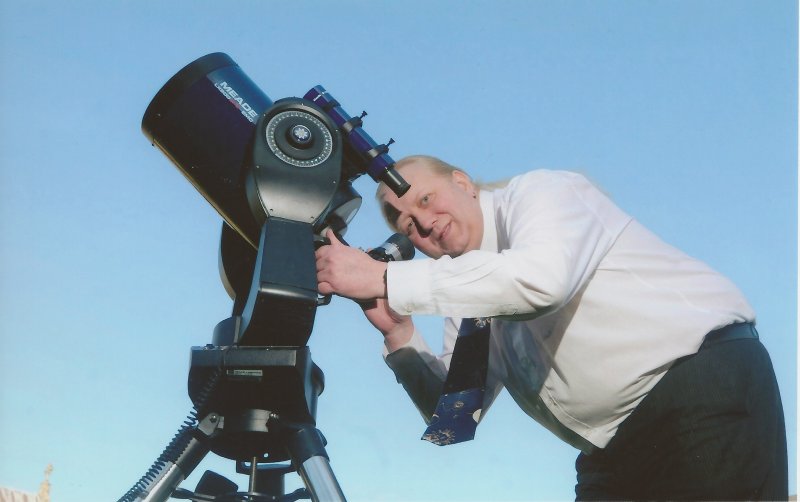
| Adrian Dening's |
| Stars Over Somerset |
| Latest News |
 |
Latest News |
| My weekly articles about what can be seen in the night sky over Somerset are broadcast every Thursday to Sunday at various times, on Yeovil's local community radio station Radio Ninesprings. |
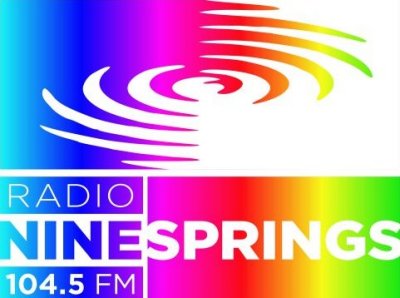 |
| Since 2022, Greg Perkins has been broadcasting the articles on Apple FM in Taunton. |
 |
| BBC Somerset also transmits Stars Over Somerset on Luke Knight's Friday evening show. |
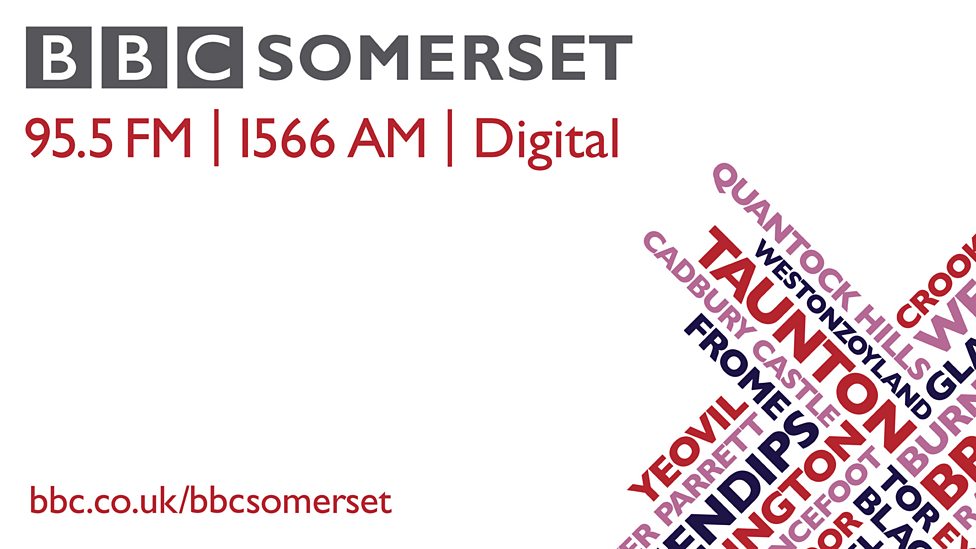 |
| Please click on the link below to hear the interview that I gave BBC Somerset: |
| Adrian Dening & Luke Knight Interview MP3 |
 |
| Monday 5th to Sunday 11th August 2024 |
|
Let's begin with a bit of a naked eye challenge on the evening of Monday 5th August. If you look towards the west north west just as the Sun is setting, say around 9pm, it should be possible to spot planet Venus close to the horizon. An even harder target to see with be a 1%-lit waxing crescent Moon, located a little to the right of Venus. |
 |
|
Much easier targets to find any evening next week are Saturn, that rises above the east south east horizon from around 11pm, followed by Jupiter and Mars towards the east north east from 2am. |
 |
 |
|
Interestingly, Saturn reaches its highest position in the night sky around 3am on Saturday 10th, when it will be located towards the south. |
 |
|
Astronomers prefer looking at things when they are higher in the sky because the light from them is passing through our atmosphere at a steeper angle, so there is less distortion. Although Saturn's rings of dust are not best-placed for observing at the moment, it would be an optimum time to dig that telescope out and see how many of Saturn's numerous moons you can spot. As a bonus, our own Moon will have already disappeared below the horizon, so it won't be causing any light pollution. |
 |
|
When I was at school, I was always taught that Jupiter had the most moons orbiting around it. There are currently 95 Jovian moons officially recognised by the International Astronomical Union. However in reality, Saturn has the most - 146 of them! Some, like Titan, are the size of small planets; others are described by NASA as being shaped like potatoes or ravioli! |
| Monday 29th July to Sunday 4th August 2024 |
|
If you are up early, around 3am on Wednesday 31st July and look towards the east north east, you will be greeted by the constellation of Taurus rising above the horizon. Taurus provides the backdrop to a triangle made by the planets Mars and Jupiter with the bright star Aldebaran in the third corner. To the left of the triangle will be a 19%-lit waning crescent Moon and above, towards the top of Taurus, the Pleiades open cluster of stars. |
 |
|
Aldebaran is the alpha (or brightest) star in the constellation. Taurus is also the location of the Crab Nebula, known as M1 as it is the first deep sky object that Charles Messier catalogued back in the mid-1700s. |
 |
|
The Crab Nebula is a supernova remnant, left over from an exploding star. It is several thousand light years away from us and only has a magnitude of around +8.4 so you will need a telescope to see it. |
 |
|
If you missed the shadows of Europa and Io as they orbited in front of Jupiter last week, there is another opportunity to spot the shadow of a transit, between 12.30am and 3.30am in the early morning of Sunday 4th August. You would definitely require a decent telescope though as this time we are talking about Saturn and one of its many moons, Dione. Around that time, Saturn can be found towards the south south east. |
 |
 |
|
Sunday 4th is also the time of the New Moon AND it will be below the horizon, so absolutely zero light pollution, making it an ideal time to go hunting those faint deep sky objects like the others listed in Charles Messier's catalogue. |
| Monday 22nd to Sunday 28th July 2024 |
|
On Wednesday 24th, if you look towards the east south east from around 11pm, an 83%-lit waning gibbous Moon will be rising above the horizon. We will have had a full Moon on 21st, so it is referred to as being "waning" because the phases are now heading towards a New Moon at the beginning of August. The term "gibbous" is derived from the Latin word meaning "humped" and in old English it is used to describe a convex shape. |
 |
|
A little above and to the right of the Moon, you will find Saturn shining at a magnitude of around +0.7 so easy to spot without a telescope. |
 |
|
Of course, if you have brought your telescope outside, you could have a go a trying to see the rings of dust that surround Saturn. This will be difficult as the rings currently appear to be "end-on" to us and so very thin. You should be able to make out some of Saturn's many moons though, like Titan and Enceladus. |
 |
|
Because of the way the Moon orbits around us, if you went back outside at 11pm on Saturday 27th, it would not be there! You would have to wait until around 1am on the Sunday morning to see it rise above the horizon and this time the Moon would be towards the east north east. The phase will no longer be gibbous and you will now see what looks like a quarter Moon. |
 |
| Monday 15th to Sunday 21st July 2024 |
|
It would definitely be worth getting up early on the morning of Monday 15th and looking towards the north east from about 3am as there are plenty of things to observe, without even having to turn your head! |
 |
|
The first target to spot would be the Pleiades open cluster of stars. Slightly down and to the right of the Pleiades you will find planet Mars shining at a magnitude of about +1.0 so easy to spot with the naked eye. |
|
If you have brought your telescope outside with you, then just above Mars, Uranus will be visible at a magnitude of +6.0 The two planets are in conjunction this morning, or in other words, the closest they appear to get to each other. If you are using your telescope, please remember to pack it safely away before the Sun rises! |
|
A much easier target is Jupiter, a bit closer to the horizon and to the left of the Pleiades. Below Jupiter, you will find one of the brightest stars in the night sky, Aldebaran. |
|
Sticking with Jupiter, if you take your telescope back out and catch Jupiter just starting to rise above the north east horizon at 2am on Wednesday 17th, it should be possible to observe the shadow of Europa and Io, two of Jupiter's Galilean moons, as they pass in front of the planet. The event will be all over by 2.30am. |
 |
|
Stars and deep sky objects only appear to move because we are moving, but the planets are much closer to us and orbiting around the Sun like us. So if you go outside again at 3am on Sunday 21st, Mars will now appear to be in conjunction with the Pleiades and Uranus will be further away from the red planet to the right. |
 |
| Monday 8th to Sunday 14th July 2024 |
|
I'm going to suggest revisiting the "Summer Triangle" which is the imaginary shape drawn between the stars Deneb in the constellation of Cygnus, Vega in Lyra and Altair in Aquila. If you venture outside around 11pm next week, the trio of stars will be located quite high in the sky towards the east. |
 |
|
From a dark location, you will notice what looks like dim cloud running through the triangle. It isn't cloud at all, rather the faint light from the multitude of stars in the middle of our Milky Way galaxy. |
 |
|
The Milky Way is a spiral galaxy with a concentration of (billions of) stars in the centre and arms spiralling outwards containing millions more. If you could travel far enough into space and look back, it would resemble a spinning Catherine Wheel, albeit moving an awful lot slower than a firework! |
 |
|
Our own Sun is one insignificant star in one of the spirals. The Milky Way is huge, measuring about 100,000 light years across, so it would take you that long to journey from one side to the other IF your spaceship travelled at the speed of light! |
|
Our Solar System and everything you see in the night sky apart from other galaxies are all within our bit of the Milky Way. If you look inwards towards the centre then you see that faint cloud in the background. If you look outwards, the next thing you see is our neighbouring Andromeda Galaxy M31, a whopping 2.5 million light years away. In between is.....er.....space! |
 |
| Monday 1st to Sunday 7th July 2024 |
|
Next week is a great time to go planet-spotting, beginning at around 3am on Monday 1st July. A 25%-lit waning crescent Moon will have risen above the horizon to the east, with the red planet Mars just to the left of it shining at a magnitude of +1.0 |
 |
|
While you are there, look towards the south east and Saturn will be easy to find, shining equally brightly. |
|
If instead you venture outside around 3.30am on Wednesday 3rd and look more towards the north east, the waning crescent Moon will now only be 9%-lit and this time, Mars will be to the right of it. Immediately below the Moon you will see Jupiter. You could also try to identify the Pleiades open cluster of stars sitting between the Moon and Mars. |
 |
| We have a New Moon on Friday 5th, so if you go outside again on Sunday evening 7th just as it's getting dark, say from 8.30pm, a 3%-lit waxing crescent Moon will be located towards the west as it sets. |
 |
|
At the same time, a magnitude -0.1 planet Mercury will be a little below and to the left of the Moon. |
 |
|
Remember that if the Moon is heading towards a New Moon, then it is referred to as being "waning" and the illuminated part of the Lunar surface will be on the left. If heading towards a Full Moon, then it's called a "waxing" phase and the illuminated part will be on the right. |
 |
|
Incidentally, on Friday 5th, the Earth reaches the furthest point in its orbit around the Sun. This position is known as "Aphelion" and we will be just over 94 million miles from the Sun. Maybe that explains the lack of summer temperatures this year! |
 |
| Monday 24th to Sunday 30th June 2024 |
|
If you are up at around 3am on the morning of Thursday 27th, a gibbous Moon will have risen above the horizon towards the south east. Just to the left of the Moon will be Saturn, shining quite brightly at a magnitude of around +0.7 |
 |
|
Remember that the Moon appears to travel differently across the night sky compared to the planets, because the Moon is orbiting around us every month while the planets, like our own Earth, are orbiting around the Sun every year. |
|
To prove this, if you repeat the experiment at 3am on Friday 28th, the Moon will be slightly more towards the east and this time, Saturn will be located to the right of the Moon. |
 |
|
How about trying to spot the dwarf planet Ceres in the Asteroid Belt? At 1am on Sunday 30th, the constellation of Sagittarius will be sitting just above the horizon to the south. Sagittarius contains an "asterism" or easily-recognisable shape known as "The Teapot". |
 |
|
Ceres will be located just below the handle of the teapot. The little 900Km diameter planet will only have a magnitude of about +7.3 so it will be time to dig that telescope out as with the naked eye from a dark location, you can only resolve objects to a magnitude of around +6.0 |
 |
|
Ceres was the first asteroid ever identified, back in 1801 and it is considered to be a dwarf planet rather than just a lump of rock like other asteroids because of its complex composition that includes water ice and different minerals. |
| Monday 17th to Sunday 23rd June 2024 |
|
Believe it or not, it is actually summer at the moment! On Monday 17th we have the earliest sunrise of the year, officially at 4.42am in London. From here in the south west, it actually occurs about ten minutes later because we live at a more-westerly longitude. |
|
Confusingly, the Summer Solstice, when the Sun reaches its most northerly point in the sky, takes place on Thursday 20th. The Earth's axis is tilted approximately 23.5 degrees and on 20th June, that angle makes the northern hemisphere point more towards the Sun. At midday, the Sun will be directly over the latitude line known as the Tropic of Cancer. |
|
Six months later, the opposite happens and the northern hemisphere is tilted away from the Sun......or in other words we have the winter solstice. |
 |
| Diagram courtesy of NBC News |
|
Stonehenge was built to align with the Sun on the solstices and every year, many people make a pilgrimage to the historic site. English Heritage are allowing free access to Stonehenge between 7pm on the Thursday evening and 8am on the Friday morning. You have to visit their website and pre-book because parking is very limited and although access to the site is free, there is a parking charge per vehicle. For those that can't make it, there will also be a livestream of the event on the English Heritage website. |
 |
| Photograph courtesy of English Heritage |
| Monday 10th to Sunday 16th June 2024 |
|
Over the last few weeks I have been mentioning deep sky objects: open and globular clusters of stars, areas of gas known as nebulas and galaxies which are collections of billions of stars, like our own Milky Way. |
|
Well there are actually five different types of nebulas and I am often asked about them, so thought it would be an interesting topic for Stars Over Somerset. |
|
First of all we have "Emission Nebulas" and the best example is the Great Orion Nebula, M42 in the Charles Messier catalogue. These are large areas of ionised Hydrogen gas that emit light and they are "stellar nurseries" where stars are being born. |
 |
|
Secondly we have "Reflection Nebulas" such as M45. Hang on.....isn't M45 the Pleiades open cluster of stars? Well yes it is, but with a powerful telescope, you can see the remains of the gas that created the stars - the gas isn't giving off its own light anymore, but it is illuminated by the reflection of light coming from the recently-formed stars. |
 |
|
The next type of nebula is known as a "supernova remnant" such as the Crab Nebula M1 in the constellation of Taurus. These nebulas are the leftovers from a star that has exploded as a supernova. |
 |
|
Then we have "Planetary Nebulas" that have nothing at all to do with planets! A good example is the Dumbbell Nebula M27 in the Summer Triangle. These are glowing ionised gases ejected from a dying red giant star. The misnomer originates from the 1700s when using early telescopes, astronomers thought their round shapes looked like planets! |
 |
|
Finally, a "dark nebula" like the famous Horsehead Nebula in Orion is a cloud of gas and dust that is revealed due to the bright material and stars behind it. The nebula is silhouetted against the bright background which creates interesting shapes. |
 |
| Monday 3rd to Sunday 9th June 2024 |
| There will be a new Moon on Thursday 6th. One day either side of that, if you fancy a challenge, you could try spotting what will be a 2%-lit crescent Moon; known as a waning crescent the day before the new Moon and a waxing crescent the day after the new Moon. |
|
On Wednesday 5th the crescent Moon will have risen above the north east horizon by 4am, just as it's getting light. You might be able to identify planet Mars at the same time over towards the east. Please don't be tempted to use binoculars or a telescope though, as the Sun will be rising in the same area. |
 |
 |
|
If evenings are more your thing, on Friday 7th the crescent Moon will be setting towards the north west just as it's getting dark, say around 10pm. One curious thing to note is that a waning crescent always appears to be on the left edge of the Moon, where a waxing crescent is always on the right. |
 |
| During the hours of darkness, the Moon will be below the horizon and this is a period favoured by astronomers because the lack of light pollution from the Moon makes it much easier to observe deep sky objects - those faint fuzzy blobs like galaxies and nebulas. Last week I mentioned the Summer Triangle which is a great area of the night sky to find different objects that are listed in the Charles Messier catalogue. |
|
The coming week would be an ideal opportunity to dig that telescope out and see if you can hunt down some of them! A star chart to help you find the Summer Triangle and identify some of the nebulas contained within it is available below, under last week's post. |
| Monday 27th May to Sunday 2nd June 2024 |
|
If you are up early on the morning of Friday 31st May, say around 4am before dawn and look towards the south east, you will be greeted by a 45%-lit waning crescent Moon with planet Saturn a little to the left of it. |
 |
|
During the summer months, astronomers enjoy looking at an area of the night sky known as the "Summer Triangle" which is formed between the stars Deneb in the constellation of Cygnus, Vega in Lyra and Altair in Aquila. Currently, if you are outside around 11pm, the Summer Triangle will have risen above the horizon to the east. |
 |
|
Why do astronomers get so excited about it? Well firstly, you will notice a patch of faint cloud running across the triangle - it's not really cloud, rather the centre of our Milky way galaxy and you are seeing the light from millions of stars in the distance. |
 |
|
The Summer Triangle is the location of many deep sky targets for your telescope, for example the Dumbbell Nebula M27 and Ring Nebula M57, so named because of their obvious shapes. There are also objects that do not appear in the Charles Messier Catalogue; instead they are listed in the New General Catalogue. You could try to spot NGC7000 which is known as the North America Nebula because it looks like the outline of the USA with the Pelican Nebula beside it. See if you can make out the shape of the pelican. |
 |
 |
|
Finally, near the middle of the triangle is the black hole Cygnus X1, but you won't see that because no light can escape from it. You would need an X-Ray telescope to detect it! |
 |
| Monday 20th to Sunday 26th May 2024 |
|
I'm going to concentrate on the early hours of Friday 24th when we have a full Moon. By 1am, the Moon will be heading towards the south and if you are outside at that time, the bright star Antares will be located a little to the left of the Moon. |
 |
|
Antares is a red supergiant and it is actually classed as a "variable star". This means that its magnitude or brightness can change between +0.6 at its brightest, down to around +1.6 and I believe that currently it is around +1.0 so very easy to spot. Antares is part of a binary star system, but you will only be able to resolve the main red supergiant star - its smaller companion will remain invisible. Antares is huge - up to 16 times the mass of our Sun and if it was placed at the centre of our Solar System, the star would extend all the way out to Jupiter! |
|
Binary stars orbit around each other because of their mutual gravity and if you can see both stars in your telescope, they are known as "visual binaries". |
|
Getting back to 1am on 24th, immediately to the left of the Moon you can find the Spider Globular Cluster of stars, also known as M4 in the Charles Messier catalogue. It will be a real challenge to see with your telescope because of the proximity of the full Moon which is the ultimate source of light pollution. |
 |
|
Globular clusters are collections of up to millions of stars, kept together by their mutual gravity and the centre of the cluster is brighter where they are concentrated. Last week I suggested looking at M44 which is an open cluster - a small group of recently-born stars who gradually drift apart from each other. |
| Monday 13th to Sunday 19th May 2024 |
|
If you are outside around 1am on the morning of Tuesday 14th, a 35%-lit waxing crescent Moon will be setting towards the western horizon. Just below and to the left of the Moon you will find a nice target for your telescope that I have mentioned before - the Beehive open cluster of stars, also known as M44 in the Charles Messier catalogue. |
 |
 |
|
It's also a week for spotting those curious clair-obscur visual effects on the lunar surface, starting with the "Lunar X and V" around 4pm on Wednesday 15th. The Moon will have risen about the horizon towards the east and even though it will be daylight, the moon should be visible, with the "X and V" on the terminator, where sunlight just illuminates the lunar surface. |
 |
 |
|
Early Friday morning 17th, around 2am, is the optimum time to observe the clair-obscur effect known as "Plato's Hook" in the crater Plato. A slightly gibbous Moon will be setting towards the west. |
 |
| The crater Plato is located towards the northern part of the Moon and is almost perfectly round with a diameter of just under 100Km. It is estimated to be almost 4 billion years old. I have provided an image below, courtesy of astronomer Pete Lawrence, to help you identify Plato's Hook. |
 |
 |
|
Finally, May is the start of the noctilucent cloud season. These night-shining clouds are caused by sunlight reflecting off water ice crystals in the upper atmosphere at twilight. They are too faint to be observed in daylight. |
 |
| Monday 6th to Sunday 12th May 2024 |
|
I am just going to concentrate on one observing opportunity this time - before dawn on Monday 6th could be a very rewarding time to make an early start! The constellation of Aquarius will just be rising above the east south east horizon from 4am and we have the peak of the Eta Aquariid meteor shower. Just below the radiant point of the shower, Saturn will be poking its head up above the horizon if you have an unobstructed view in that direction. |
 |
|
At 4.17am, if you turn your gaze towards the west, the International Space Station should appear. It will look like a bright star that is moving silently and the ISS will pass almost directly overhead, before disappearing 7 minutes later in the vicinity of the meteor shower's radiant point. How cool is that! |
 |
|
Saturn will have a magnitude of around +1.07 so should be fairly easy to spot. The ISS at that point will have a magnitude of approximately -1.31 or in other words, you won't be able to miss it! |
|
If you delay heading back indoors for breakfast, Mars will then pop up above the eastern horizon and from around 5am, a very thin crescent Moon makes an appearance in the same direction. |
 |
|
Although Mars will have a magnitude around +1.2 it will be much harder to spot against the dawn sky. The Sun will be rising shortly afterwards, which prompts me to give my usual warning about not taking the risk of using your telescope or binoculars, in case you accidentally catch a glimpse of it in the eyepiece. |
| Monday 29th April to Sunday 5th May 2024 |
|
First of all, something for the early risers! From 4.30am on the morning of Wednesday 1st May, a quarter Moon will be just rising above the south east horizon. This is an optimum time to observe one of the lesser-known clair-obscur visual effects on the lunar surface called "The Cutlass" because of its obvious sword-like shape. |
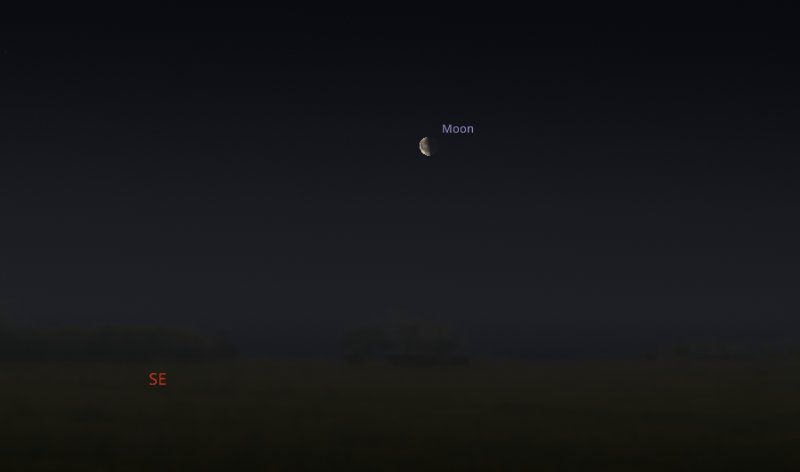 |
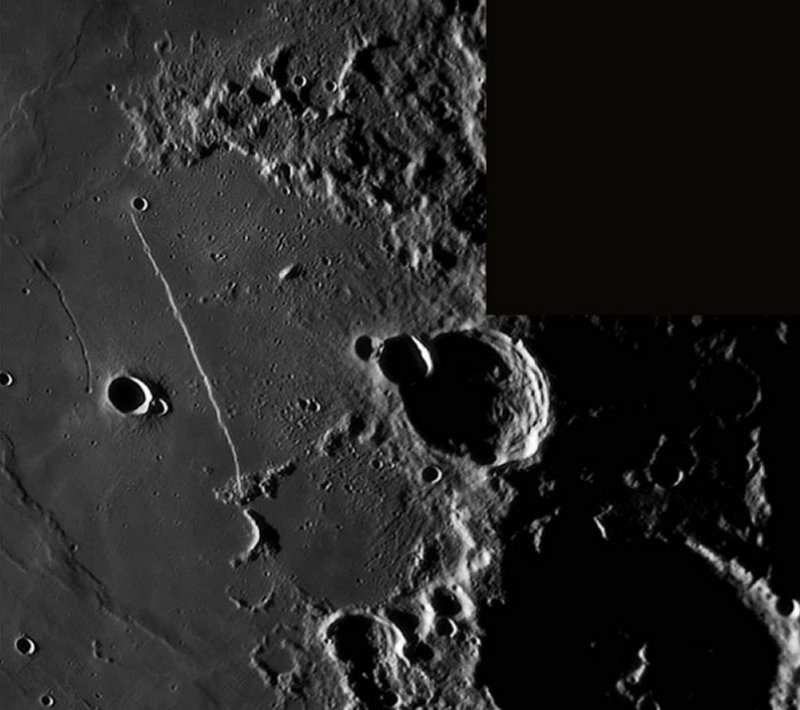 |
|
At 2am on the morning of Friday 3rd, the famous "Globular Cluster in Hercules" reaches its highest point in the sky - this is the best time to observe the cluster as light from its hundreds of thousands of stars will be passing through less of our atmosphere. Remember it is distortion created by our atmosphere that makes stars appear to twinkle and so the higher the angle, the better. |
|
The constellation of Hercules will be located high in the sky towards the south east and the cluster, also known as M13 in the Charles Messier Catalogue can be found roughly halfway between the bright stars Vega in Lyra and Arcturus in Bootes. It is just to the right of the asterism (or shape) referred to as "The Keystone" in Hercules. |
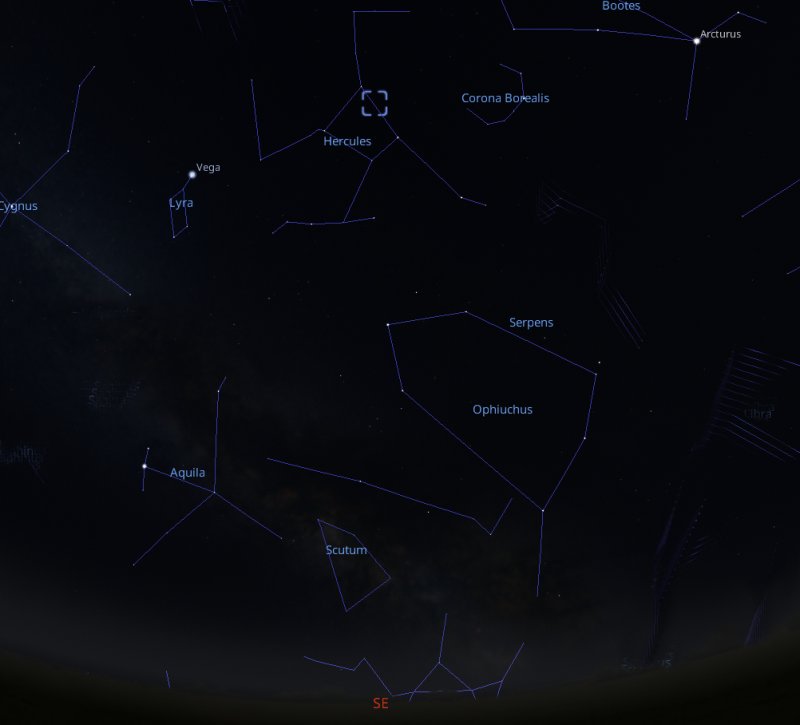 |
| To the naked eye, from a dark location, the cluster will appear as a fuzzy blob. Binoculars or a small telescope will start to reveal the detail with a bright centre where the stars are most concentrated. I have provided an image below of what you are looking for, courtesy of Wikipedia. |
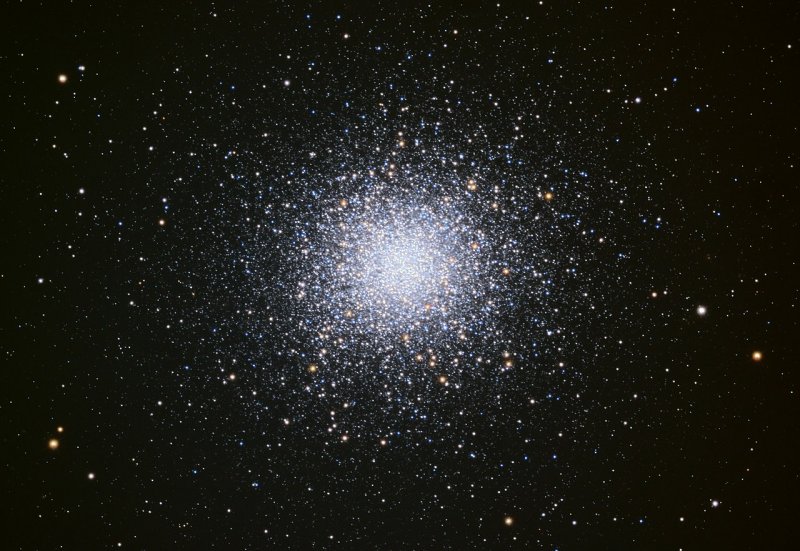 |
|
Finally, there are a couple of excellent opportunities to spot the International Space Station during the coming week; Tuesday 30th April at 4.24am and Friday 3rd May at 3.35am. In both cases, the ISS will appear towards the west and pass almost directly overhead. |
|
Screenshots courtesy of Stellarium |
|
Copyright Adrian Dening and Radio Ninesprings 2024 |
| To enquire about local astronomy talks and star parties |
| please contact Adrian Dening |
| 07545 641068 |
| info@starsoversomerset.com |
| Designed for 1024 x 768 resolution |